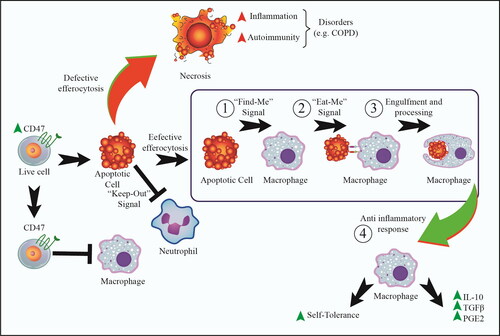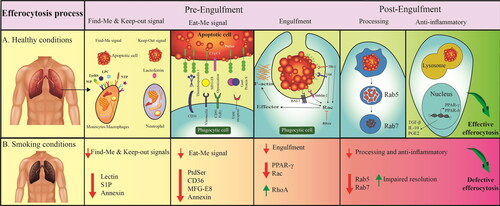Figures & data
Figure 1. The main efferocytosis signaling and steps. These signals are related to the apoptotic cells (ACs), characterizing by ‘Find-Me’ signals and also the absence of ‘Don’t Eat-Me’ signals. ‘Don’t Eat-Me’ signals, such as CD47 and CD31 commonly found on living cells. However, there are major steps in efferocytosis including: (1): ‘Find-Me’ signals (to attract phagocytes to sites of apoptotic cell death), (2): ‘Eat-Me’ signal (to catch ACs), and (3): the processes of engulfment and digestion. Ultimately, effective efferocytosis results in 4): the production of anti-inflammatory cytokines, such as IL-10 and TGF-β. Moreover, an additional steps include ‘Keep-Out’ signal helps to efferocytosis to reduce number of unwanted neutrophils. On the other hand, defective efferocytosis can lead to necrosis, which in turn increases inflammation and inflammatory diseases, such as COPD. In this line, cigarette smoke can impair efferocytosis activity, which leads to necrosis and tissue inflammation.

Figure 2. Effective and defective efferocytosis signaling. A: Effective efferocytosis in the physiologic condition that is regulated by certain pathways/factors; B: Defective efferocytosis in pathophysiological conditions caused by cigarette smoking. Abbreviations: BAI-1: Brain-specific angiogenesis factor 1; C1q: Complement component 1q; CD36: Cluster of differentiation 36; FCRγ: Fc receptor γ-chain; Gas6: Growth Arrest Specific 6; IL-10: Interleukin 10; LPC: Lysophosphatidylcholine; MerTK: Mer tyrosine kinase; MGF-E8: Milk fat globule‑EGF factor 8; NTP: Nucleoside triphosphate; PGE2: Prostaglandin E2; PPAR: Peroxisome proliferator activated receptor; PtdSer: Phosphatidylserine; S1P: Sphingosine 1-phosphate; TGF-β: Transforming growth factor beta; TIM-1: T-cell immunoglobulin and mucin domain 1; TyrRS: Tyrosyl-tRNA synthetase.

Table 1. The main efferocytosis related-molecules.
Table 2. The main defective efferocytosis-related factors/pathways that are affected by CS in COPD.
Table 3. The regents that have the potential therapeutic effect for treating CS-related lung injury.
Data availability statement
Data sharing not applicable to this article as no datasets were generated or analyzed during the current study.
